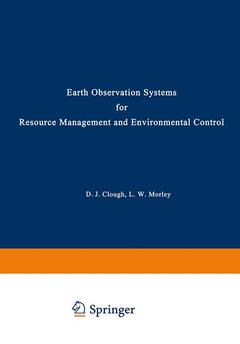Description
Earth Observation Systems for Resource Management and Environmental Control, 1977
II Systems Science Series
Language: English
Subject for Earth Observation Systems for Resource Management and...:
Keywords
development; environment; formation; organization; production; remote sensing; research; soil
Publication date: 12-2012
475 p. · Paperback
475 p. · Paperback
Description
/li>Contents
/li>
The NATO Science Committee and its subsidiary Programme Panels provide support for Advanced Research Institutes (ARI) in various fields. The idea is to bring together scientists of a chosen field with the hope that they will achieve a consensus on research direc tions for the future, and make recommendations for the benefit of a wider scientific community. Attendance is therefore limited to those whose experience and expertise make the conclusions significant and acceptable to the wider community. Participants are selected on the basis of substantial track records in research or in the synthesis of research results to serve mankind. The proposal for a one-week ARIon Earth Observation and In formation Systems was initiated by the NATO Special Programme Panel on Systems Science (SPPOSS). In approving the ARI, the senior NATO Science Committee identified the subject as one of universal impor tance, requiring a broad perspective on the development of opera tional systems based on successful experimental systems. The general purpose of this ARI was to address the critical problems of integrating the relatively new science and technology of remote sensing into operational earth observation and manage ment information systems. The main problems of concern were those related to systems design, organization, development of infrastruc ture, and use of information in decision processes. The main empha sis was on problems of transferring technologies and methods from experimental to operational systems.
1: Overview Summary Report.- Conclusions and Recommendations.- 2: Summary Reports of Working Groups.- A: Platforms and Sensors.- B: Data Handling Systems.- C: Management Information Systems.- D: Socio-Economic Systems Aspects.- 1: Atmospheric Applications.- 2: Land Applications.- 3: Ocean Applications.- 4: Evaluation Methodology.- 3: Background Papers.- 1. Earth Observation Systems.- 2. EPA’s Use of Remote Sensing in Ocean Monitoring.- 3. Information Requirements for Regional and Global Operational Systems in Agricultural Meteorology.- 4. Identifying the Optimum System for Observing Earth.- 5. Benefits of LANDSAT Follow-on (Operational System).- 6. Satellite Observation Systems and Environmental Forecasts: Progress and Prospects.- 7. Some Considerations Relative to the Making of Globally Uniform Resource Inventories by Remote Sensing.- 8. Data Processing and Distribution for Earth Observation Satellites.- 9. Soil Diagnosis Through Remote Sensing.- 10. Development and Prospects of Remote Sensing Applied to European Renewable Earth Resources.- 11. Planning for an Earth Resources Information System.- 12. Application of Remote Sensing for Policy, Planning and Management in Forestry and Agriculture.- 13. Concepts of Remote Sensing Applications for Food Production in Developing Countries.- 14. Specifications for Some Satellite Applications for Data Telemetry and Platform Location.- 15. Information Values of Remote Sensing.- 16. The Potential Economic Benefits of an Oceanographic Satellite System to Commercial Ocean Operations.- 17. Research, Application and Requirements of a Major User of LANDSAT.- 18. A Crop Production Alarm System.- 19. Applications of Remote Sensing and Information Systems to Coastal Zone Management.- 20. An Operational Earth Resources Monitoring andManagement System: Some Problems and Solutions Related to Land Areas.- 21. Operational Remote Sensing Systems for Environmental Monitoring and Regional Planning.- 22. Digital Enhancement and Analysis Techniques in Processing Earth Resources Data.- 23. Requirements for Real-Time Oceanography from Earth Observation Systems.- 24. The Use of Satellite Data in Ocean Engineering.- 25. The Availability and Use of Satellite Pictures in Recognizing Hazardous Weather 4l.- 26. Accurate 24-hour Weather Forecasts: An Impending Scientific Breakthrough.- List of Contributors.
© 2024 LAVOISIER S.A.S.

